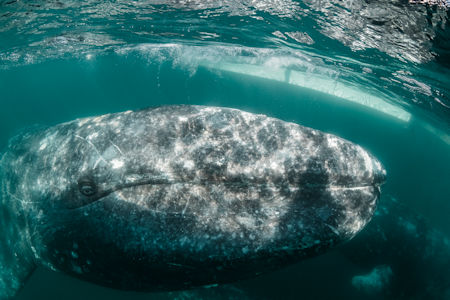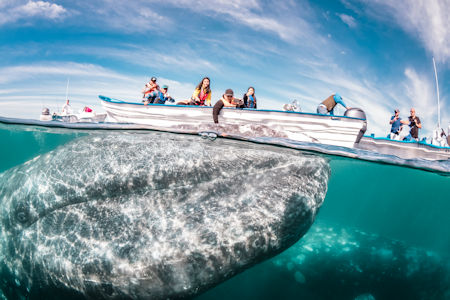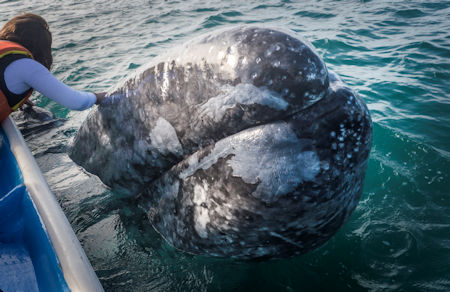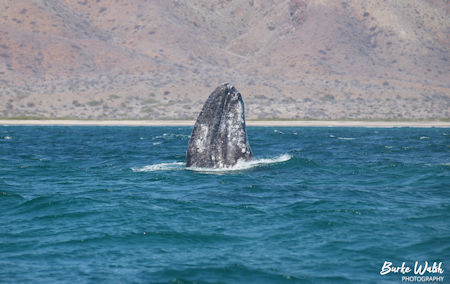 |  |
An insight into the biology, life-history and ecotourism opportunities of Baja’s gray whales

The record for the longest known mammalian migration is held by none other than the gray whale (Eschrichtius robustus). The eastern North Pacific population, also known as the North American population, makes a round-trip of some 16,000 – 23,000 kilometres. This gargantuan migration involving an estimated 28,000 individuals, begins in the Bearing and Chukchi Seas of the Arctic: their summer feeding grounds.
Each winter, a substantial number of gray whales travel to one of several warm-water lagoons off the Baja Peninsula for the purpose of calving and seeking mates. From north to south, these are Laguna Ojo de Liebre, Laguna San Ignacio and Magdalena Bay.
The recording-holding individual gray whale was given the name Varvara by her researchers. She made the longest known migration of any mammal, traveling a staggering 23,000 kilometres across the northern Pacific Ocean from Sakhalin Island in Russia to the Baja California Peninsula just shy of Los Cabos and back again. Her round-trip journey took her the best part of six months.
Because the Eastern North Pacific gray whales largely migrate close to the coastline, they can often be observed at numerous locations along the Canadian, United States and Mexican Pacific coasts.

The Gray whale
The gray whale is one of 15 species of baleen whale that can reach lengths of almost 15 metres / 50 feet. It’s not too surprising then that the calves are born already measuring in the region of three to five metres after a gestation period of around 13.5 months. Nourished by the 50+% milk of their mothers’, gray whale calves grow quickly in preparation for their first ever journey to their summer feeding grounds in the Arctic seas. Adults can weigh up to a colossal 36 tons and it is believed that the species have a somewhat similar life-span to that of humans: around 70 years or so.
Most species of baleen whales filter-feed on plankton, krill and small fish using either a lunge-feeding or skim-feeding method for catching their prey. In contrast, the gray whale differs in that it specializes in feeding on benthic or bottom-dwelling animals collectively referred to as benthos. By turning on their sides, they are able to “rake” the seabed, filtering out benthic crustaceans such as crabs, lobsters, krill, amphipods and copepods while possibly consuming a wide-range of other invertebrates in the process.
Gray whale summer feeding grounds
The Chukchi Sea lies between Russia and Alaska in the United States. In its southernmost limit, it is connected to the Bering Sea by the Bering Strait and it is this 2.5 million or so square kilometer region that forms the summer feeding grounds for the North American gray whale population. The whales will spend around seven months of their year feasting in these cold, highly productive waters before the ice cap advances causing much the region to freeze over.
Laguna Ojo de Liebre
Laguna Ojo de Liebre is often referred to as Scammon’s lagoon though this is not its preferred name due to the whale hunting associated with it that contributed to driving the population to near-extinction in the mid-1800’s. This important calving ground for gray whales lays within the Vizcaíno Biosphere Reserve UNESCO World Heritage Site.
It is located roughly halfway down the Baja Peninsula just a few miles south of Guerrero Negro and is visited by a rough average of 1,500 gray whales each year though the 2019 season estimated abundance was considerably less.
The drive there from the US border will take you around 10 hours. The final 35 or so kilometres is dirt road that is easily accessed by any vehicle when conditions are dry. There is a simple camping area near the water’s edge and the city of Guerrero Negro is close enough to use as a base.

Laguna San Ignacio
Around 100 kilometres further south of Laguna Ojo de Liebre is Laguna San Ignacio which also falls within the Vizcaíno Biosphere Reserve. It is 59 kilometres west of the town of San Ignacio and Highway 1. This coastal lagoon penetrates 26 kilometres into the Baja desert and is 8 kilometres at its widest point. Laguna San Ignacio was a winter home to an estimated 216 gray whale individuals in 2019. Stay-over options include solar-powered campsites, wooden cabins and a few simple bungalows.
Magdalena Bay
Magdalena Bay is the southern-most of the coastal lagoons used by gray whales for calving. It is the most easily accessible and closest to the cities of Los Cabos and La Paz. Spanning some 1,000 square kilometres, this large bay is located in Baja’s southern state close to the town of Insurgentes. Within this bay are several ports from which one can join a gray whale-watching boat. These include Puerto San Carlos, Puerto Adolfo Lopez Mateos and Puerto Chale. This area is a little more developed than the other options in that it has a choice of small hotels, restaurants and souvenir shops to complete your experience. The drive there is paved all the way in. The journey from Cabo San Lucas takes around 5.5 hours and is around 3.5 hours from La Paz.
Visiting the domain of the gray whale is nothing short of exhilarating. Some visitors describe it as “spiritual”, “healing”, and even “life-changing”.
One statement I can make from personal experience, is that witnessing an 11-metre female gray whale “tuck” her head under our boat, much like your dog may tuck its snout under your arm or your newspaper in anticipation of receiving physical affection, is for sure an astonishing experience to witness.

It’s good to note that no two whale-watching tours are the same. On some trips, guests may be fortunate enough to pet a whale or two while on others, the passengers may only see the whales from a distance. For this reason, it is better to participate in at least two, 2-hour whale watching excursions to increase your chances of a good interaction. The whales will either initiate physical interaction, or they won’t. It is vitally important to not try to force it.
For more information about whale-watching tours in Baja, you can contact me directly or visit my website.
Contact:
+52 1 (612) 197 5824
Website
bajawildlifediaries[at]gmail.com